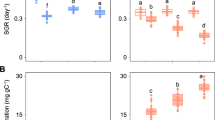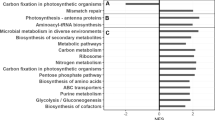Abstract
Diatoms are responsible for ∼40% of marine primary productivity1, fuelling the oceanic carbon cycle and contributing to natural carbon sequestration in the deep ocean2. Diatoms rely on energetically expensive carbon concentrating mechanisms (CCMs) to fix carbon efficiently at modern levels of CO2 (refs 3, 4, 5). How diatoms may respond over the short and long term to rising atmospheric CO2 remains an open question. Here we use nitrate-limited chemostats to show that the model diatom Thalassiosira pseudonana rapidly responds to increasing CO2 by differentially expressing gene clusters that regulate transcription and chromosome folding, and subsequently reduces transcription of photosynthesis and respiration gene clusters under steady-state elevated CO2. These results suggest that exposure to elevated CO2 first causes a shift in regulation, and then a metabolic rearrangement. Genes in one CO2-responsive cluster included CCM and photorespiration genes that share a putative cAMP-responsive cis-regulatory sequence, implying these genes are co-regulated in response to CO2, with cAMP as an intermediate messenger. We verified cAMP-induced downregulation of CCM gene δ-CA3 in nutrient-replete diatom cultures by inhibiting the hydrolysis of cAMP. These results indicate an important role for cAMP in downregulating CCM and photorespiration genes under elevated CO2 and provide insights into mechanisms of diatom acclimation in response to climate change.
This is a preview of subscription content, access via your institution
Access options
Subscribe to this journal
Receive 12 print issues and online access
$209.00 per year
only $17.42 per issue
Buy this article
- Purchase on Springer Link
- Instant access to full article PDF
Prices may be subject to local taxes which are calculated during checkout




Similar content being viewed by others
References
Nelson, D. M., Treguer, P., Brzezinski, M. A., Leynaert, A. & Queguiner, B. Production and dissolution of biogenic silica in the ocean: Revised global estimates, comparison with regional data and relationship to biogenic sedimentation. Glob. Biogeochem. Cycles 9, 359–372 (1995).
Ducklow, H. W., Steinberg, D. K. & Buesseler, K. O. Upper ocean carbon export and the biological pump. Oceanography 14, 50–58 (2001).
Badger, M. R. et al. The diversity and coevolution of Rubisco, plastids, pyrenoids, and chloroplast-based CO2-concentrating mechanisms in algae. Can. J. Bot. 76, 1052–1071 (1998).
Giordano, M., Beardall, J. & Raven, J. A. CO2 concentrating mechanisms in algae: Mechanisms, environmental modulation, and evolution. Annu. Rev. Plant Biol. 56, 99–131 (2005).
Reinfelder, J. R. Carbon concentrating mechanisms in eukaryotic marine phytoplankton. Annu. Rev. Mar. Sci. 3, 291–315 (2011).
Berner, R. A. The long-term carbon cycle, fossil fuels and atmospheric composition. Nature 426, 323–326 (2003).
Sabine, C. L. et al. The oceanic sink for anthropogenic CO2 . Science 305, 367–371 (2004).
Le Quéré, C. et al. The global carbon budget 1959–2011. Earth Syst. Sci. Data Discuss. 5, 165–185 (2012).
Caldeira, K. & Wickett, M. Anthropogenic carbon and ocean pH. Nature 425, 365 (2003).
Hopkinson, B. M., Dupont, C. L., Allen, A. E. & Morel, F. M. M. Efficiency of the CO2-concentrating mechanism of diatoms. Proc. Natl Acad. Sci. USA 108, 3830–3837 (2011).
Moore, J. K., Doney, S. C., Glover, D. M. & Fung, I. Y. Iron cycling and nutrient-limitation patterns in surface waters of the World Ocean. Deep-Sea Res. II 49, 463–507 (2002).
Hennon, G. M. M., Quay, P., Morales, R. L., Swanson, L. M. & Armbrust, E. V. Acclimation conditions modify physiological response of the diatom Thalassiosira pseudonana to elevated CO2 concentrations in a nitrate-limited chemostat. J. Phycol. 253, 243–253 (2014).
Feely, R. A., Sabine, C. L., Hernandez-Ayon, J. M., Ianson, D. & Hales, B. Evidence for upwelling of corrosive ‘acidified’ water onto the continental shelf. Science 320, 1490–1492 (2008).
Ciais, P. et al. in Climate Change 2013: The Physical Science Basis (eds Stocker, T. F. et al.) 465–570 (IPCC, Cambridge Univ. Press, 2013).
Mock, T. et al. Whole-genome expression profiling of the marine diatom Thalassiosira pseudonana identifies genes involved in silicon bioprocesses. Proc. Natl Acad. Sci. USA 105, 1579–1584 (2008).
Carvalho, R. N., Bopp, S. K. & Lettieri, T. Transcriptomics responses in marine diatom Thalassiosira pseudonana exposed to the polycyclic aromatic hydrocarbon benzo[a]pyrene. PLoS ONE 6, e26985 (2011).
Thamatrakoln, K., Korenovska, O., Niheu, A. K. & Bidle, K. D. Whole-genome expression analysis reveals a role for death-related genes in stress acclimation of the diatom Thalassiosira pseudonana. Environ. Microbiol. 14, 67–81 (2012).
Shrestha, R. P. et al. Whole transcriptome analysis of the silicon response of the diatom Thalassiosira pseudonana. BMC Genomics 13, 499 (2012).
Ashworth, J. et al. Genome-wide diel growth state transitions in the diatom Thalassiosira pseudonana. Proc. Natl Acad. Sci. USA 110, 7518–7523 (2013).
Bender, S. J., Durkin, C. A., Berthiaume, C. T., Morales, R. L. & Armbrust, E. V. Transcriptional responses of three model diatoms to nitrate limitation of growth. Front. Mar. Sci. 1, 3 (2014).
Samukawa, M., Shen, C., Hopkinson, B. M. & Matsuda, Y. Localization of putative carbonic anhydrases in the marine diatom, Thalassiosira pseudonana. Photosynth. Res. 121, 235–249 (2014).
Xu, Y., Feng, L., Jeffrey, P. D., Shi, Y. & Morel, F. M. M. Structure and metal exchange in the cadmium carbonic anhydrase of marine diatoms. Nature 452, 56–61 (2008).
Ohno, N. et al. CO2-cAMP-responsive cis-elements targeted by a transcription factor with CREB/ATF-like basic zipper domain in the marine diatom Phaeodactylum tricornutum. Plant Physiol. 158, 499–513 (2012).
Rayko, E., Maumus, F., Maheswari, U., Jabbari, K. & Bowler, C. Transcription factor families inferred from genome sequences of photosynthetic stramenopiles. New Phytol. 188, 52–66 (2010).
Krishna, S., Andersson, A. M. C., Semsey, S. & Sneppen, K. Structure and function of negative feedback loops at the interface of genetic and metabolic networks. Nucleic Acids Res. 34, 2455–2462 (2006).
Matsuda, Y., Nakajima, K. & Tachibana, M. Recent progresses on the genetic basis of the regulation of CO2 acquisition systems in response to CO2 concentration. Photosynth. Res. 109, 191–203 (2011).
Hammer, A., Hodgson, D. R. W. & Cann, M. J. Regulation of prokaryotic adenylyl cyclases by CO2 . Biochem. J. 396, 215–218 (2006).
Dickson, V. K., Pedi, L. & Long, S. B. Structure and insights into the function of a Ca2+-activated Cl− channel. Nature 516, 213–218 (2014).
Qu, Z. & Hartzell, H. Bestrophin Cl− channels are highly permeable to HCO3−. Am. J. Cell Physiol. 294, 1371–1377 (2008).
Nakajima, K., Tanaka, A. & Matsuda, Y. SLC4 family transporters in a marine diatom directly pump bicarbonate from seawater. Proc. Natl Acad. Sci. USA 110, 1767–1772 (2013).
Lewis, E. & Wallace, D. Program Developed for CO2 System Calculations (Carbon Dioxide Information Analysis Center, Oak Ridge National Laboratory, 1998); http://cdiac.ornl.gov/oceans/co2rprt.html
Harada, H., Nakajima, K., Sakaue, K. & Matsuda, Y. CO2 sensing at ocean surface mediated by cAMP in a marine diatom. Plant Physiol. 142, 1318–1328 (2006).
Robinson, M. D. & Oshlack, A. A scaling normalization method for differential expression analysis of RNA-seq data. Genome Biol. 11, R25 (2010).
Mullner, D. Dastcluster: Fast hierarchical, agglomerative clustering routines for R and Python. J. Stat. Softw. 53, 1–18 (2013).
Reiss, D. J., Baliga, N. S. & Bonneau, R. Integrated biclustering of heterogeneous genome-wide datasets for the inference of global regulatory networks. BMC Bioinform. 7, 280 (2006).
Bailey, T. & Elkan, C. Fitting a Mixture Model by Expectation Maximization to Discover Motifs in Biopolymers (Univ. California, 1994); http://biofactory.org/sites/default/files/presentations/motif.pdf
Gupta, S., Stamatoyannopoulos, J. A., Bailey, T. L. & Noble, W. S. Quantifying similarity between motifs. Genome Biol. 8, R24 (2007).
Eddy, S. R. Accelerated profile HMM searches. PLoS Comput. Biol. 7 (2011).
Katoh, K. & Standley, D. M. MAFFT multiple sequence alignment software version 7: Improvements in performance and usability. Mol. Biol. Evol. 30, 772–780 (2013).
Waterhouse, A. M., Procter, J. B., Martin, D. M. A., Clamp, M. & Barton, G. J. Jalview Version 2-A multiple sequence alignment editor and analysis workbench. Bioinformatics 25, 1189–1191 (2009).
Crawfurd, K. J., Raven, J. A., Wheeler, G. L., Baxter, E. J. & Joint, I. The response of Thalassiosira pseudonana to long-term exposure to increased CO2 and decreased pH. PLoS ONE 6, 1–9 (2011).
Acknowledgements
National Science Foundation (Grants OCB-0928561 and MCB-1316206 to M.V.O. and N.S.B.; OCE-0927238 to E.V.A.), Gordon and Betty Moore Foundation (Grant 537.01 to E.V.A.). We thank S. Amin for comments on the manuscript and B. Durham for advice on RT-qPCR.
Author information
Authors and Affiliations
Contributions
G.M.M.H., R.L.M. and R.D.G. carried ot RNA sample preparation, sequencing and RT-qPCR. G.M.M.H., J.A. and C.B carried out bioinformatics and statistics. G.M.M.H., J.A., M.V.O., N.S.B. and E.V.A. carried out experimental design. The manuscript was prepared by G.M.M.H., J.A., R.D.G. and E.V.A. All authors contributed to discussion of results and comments on the manuscript.
Corresponding authors
Ethics declarations
Competing interests
The authors declare no competing financial interests.
Rights and permissions
About this article
Cite this article
Hennon, G., Ashworth, J., Groussman, R. et al. Diatom acclimation to elevated CO2 via cAMP signalling and coordinated gene expression. Nature Clim Change 5, 761–765 (2015). https://doi.org/10.1038/nclimate2683
Received:
Accepted:
Published:
Issue Date:
DOI: https://doi.org/10.1038/nclimate2683
This article is cited by
-
Short-term acidification promotes diverse iron acquisition and conservation mechanisms in upwelling-associated phytoplankton
Nature Communications (2023)
-
Increased genetic diversity loss and genetic differentiation in a model marine diatom adapted to ocean warming compared to high CO2
The ISME Journal (2022)
-
Enhancement of diatom growth and phytoplankton productivity with reduced O2 availability is moderated by rising CO2
Communications Biology (2022)
-
Community context and pCO2 impact the transcriptome of the “helper” bacterium Alteromonas in co-culture with picocyanobacteria
ISME Communications (2022)
-
Ocean acidification conditions increase resilience of marine diatoms
Nature Communications (2018)



